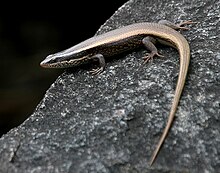Eutropis macularia
| Eutropis macularia | |
|---|---|

| |
| Eutropis macularia at Pocharam, Andhra Pradesh. | |
| Scientific classification | |
| Domain: | Eukaryota |
| Kingdom: | Animalia |
| Phylum: | Chordata |
| Class: | Reptilia |
| Order: | Squamata |
| Family: | Scincidae |
| Genus: | Eutropis |
| Species: | E. macularia
|
| Binomial name | |
| Eutropis macularia (Blyth, 1853)
| |
| Synonyms | |
|
Mabuya macularia (Blyth, 1853) | |
The bronze grass skink, bronze mabuya or speckled forest skink (Eutropis macularia), is a species of skink found in South and Southeast Asia.[2][3] It is a common, but shy, ground-dwelling species that is active both day and night.
Description
[edit]
The bronze grass skink has a cylindrical body, dorsal scales with 5–8 keels, and smooth ventral scales. A pair of dorso-lateral bands start from above the eye and extend to the base of the tail. As with other Eutropis species, the scales are keeled. The snout is short, obtusely keeled and acuminate, and the lower eyelid is scaly. The nostril is located behind the vertical suture between the rostral scale and the first labial scale. The ear-opening is oval, about the same size as a lateral scale, or a little smaller. The dorsal, nuchal, and lateral scales have five to seven sharp keels, and there are 26 to 30 scales, approximately equal in size, round the middle of the body. The adpressed limbs meet or overlap. The digits are short and the lamellae between them smooth. The tail is 1.25 to 1.75 times the length of the head and body. Brown or olive-brown above, sides darker and usually with white black-edged spots; back uniform, or black-spotted, or with one or two black longitudinal lines; sometimes there are two light lateral lines on each side, clearly delineated only in the neck region; the underparts are yellowish (in preserved specimens).[4][5] Deep-brown, olive or bronze-brown in color; dorso-lateral bands light or yellow; sometimes with black spots on the base of the tail. Breeding males have orange color on the lateral side of the body. Juveniles are grey with a bronze head.[5] Maximum length 23 cm (9 in), but a more common length is 16 cm (6 in), with a snout-to-vent length of 7 cm (2.8 in).[2]
On the leg, just above the ankle, there is a specialized group of scales which form a chigger-mite refuge.[3]
Distribution and habitat
[edit]This skink is found in Bangladesh, Bhutan, Cambodia, India, Laos, Malaysia (northwestern), Myanmar, Nepal, Pakistan, Sri Lanka, Thailand and Vietnam. Type locality is Rangpur, Bengal [Bangladesh].[3] It lives in both deciduous and evergreen forests, in plantations, among leaf litter, in grasslands, and in rocky areas with scattered trees, at altitudes up to about 1,500 m (5,000 ft).[6]
Ecology
[edit]Like other skinks, the bronze grass skink feeds on insects and other invertebrates. It hides in holes in the ground, in crevices and under rocks. The females lay several small clutches of eggs each year, each containing three to six eggs.[6] In a study in the southern Western Ghats, Eutropis macularia was the most frequently encountered reptile in the plantations, orchards and gardens where the study was conducted, being active both day and night. The skink favoured areas with a high canopy, deep leaf litter, and a dense cover of shrubs and herbs.[7] It is strictly terrestrial and is rather shy.[2]
Gallery
[edit]-
Bronze Grass Skink (Eutropis macularia) close up, at BNHS Nature Reserve (CEC), Goregaon, Mumbai, Maharashtra.
-
Bronze Grass Skink (Eutropis macularia), at BNHS Nature Reserve (CEC), Goregaon, Mumbai, Maharashtra.
References
[edit]- ^ Cota, M.; Wogan, G.; Lwin, K.; Sumontha, M.; Neang, T.; et al. (2021). "Eutropis macularia". IUCN Red List of Threatened Species. 2021: e.T172660A1361346. doi:10.2305/IUCN.UK.2021-3.RLTS.T172660A1361346.en. Retrieved 27 June 2023.
- ^ a b c "Speckled Forest Skink". Ecology Asia. Retrieved 17 February 2021.
- ^ a b c Eutropis macularia at the Reptarium.cz Reptile Database. Accessed 19 July 2014.
- ^ Boulenger, G. A. 1890. Fauna of British India. Reptilia and Batrachia.
- ^ a b "Eutropis macularia (Blyth, 1853)". Reptiles of Madhya Pradesh. Snake Research Organization Ujjain. 2014. Archived from the original on 24 October 2017. Retrieved 12 October 2015.
- ^ a b "Eutropis macularia (Blyth, 1853): bronze grass skink". India Biodiversity Portal. Biodiversity India. 2021. Retrieved 16 February 2021.
- ^ Jayakumar, Abhirami Mini & Nameer, Paingamadathil Ommer (2018). "Species composition and abundance estimates of reptiles in selected agroecosystems in southern Western Ghats". Journal of Threatened Taxa. 10 (10): 12328–12336. doi:10.11609/jott.3652.10.10.12328-12336.
Further reading
[edit]- Annandale, N. 1909 Rec. Ind. Mus. 3: 257
- Blanford, W.T. 1879 Notes on a collection of reptiles and frogs from the neighbourhood of Ellore and Dumagudem. J. Asiat. Soc. Bengal xlviii: 109–116
- Blyth, E. 1854 Notices and descriptions of various reptiles, new or little-known. Part I. J. Asiat. Soc. Bengal 22 [1853]: 639–655
- Das I. 1991 A new species of Mabuya from Tamil Nadu State, Southern India (Squamata: Scincidae). Journal of Herpetology 25 (3): 342–344.
- Mausfeld, P.; Vences, M. Schmitz, A. & Veith, M. 2000 First data on the molecular phylogeography of scincid lizards of the genus Mabuya. Mol. Phylogenet. Evol. 17 (1): 11–14
- IUCN Red List least concern species
- Eutropis
- Reptiles of Bangladesh
- Reptiles of Bhutan
- Reptiles of Cambodia
- Reptiles of India
- Reptiles of Laos
- Reptiles of Malaysia
- Reptiles of Myanmar
- Reptiles of Nepal
- Reptiles of Pakistan
- Reptiles of Sri Lanka
- Reptiles of Thailand
- Reptiles of Vietnam
- Reptiles described in 1853
- Taxa named by Edward Blyth



